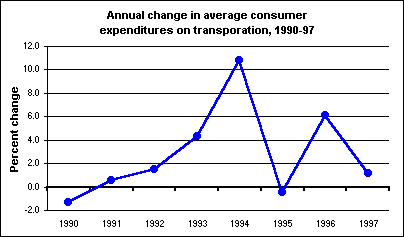An official website of the United States government
 United States Department of Labor
United States Department of Labor
After having risen by 6.1 percent the previous year, spending on transportation increased by only 1.2 percent in 1997. Consumer units spent an average of $6,457 for transportation-related expenditures during the year.

[Chart data—TXT]
Vehicle purchases are the largest transportation component and accounted for 42 percent of transportation spending in 1997. During the year, spending on vehicle purchases dropped by 2.8 percent, after rising 6.7 percent in 1996. Vehicle purchases fluctuate widely from year to year because relatively small changes in the percentage of consumer units buying expensive, infrequently purchased vehicles have a large effect on the average.
Spending on public transportation decreased 8.0 percent in 1997, following a 20.3-percent increase the previous year. Public transportation includes airline, ship, and train fares, as well as mass transit.
While expenditures on vehicle purchases and public transportation fell in 1997, spending on "other vehicle expenses" and on gasoline and motor oil increased, by 8.4 percent and 1.5 percent respectively. Other vehicle expenses account for about a third of overall transportation costs and include vehicle finance charges, maintenance and repairs, vehicle insurance, and vehicle rentals and leasing.
These data are a product of the BLS Consumer Expenditure Survey. Additional information is available from "Consumer Expenditures in 1997", Report 927.
Bureau of Labor Statistics, U.S. Department of Labor, The Economics Daily, Transportation spending brakes in 1997 at https://www.bls.gov/opub/ted/1999/mar/wk4/art02.htm (visited December 22, 2025).

